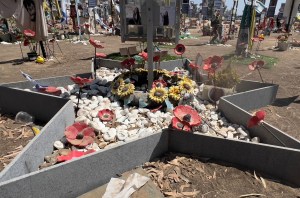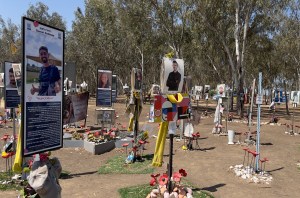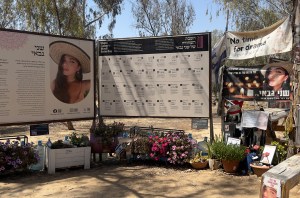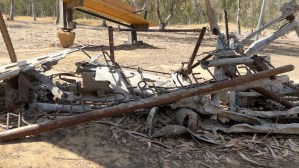
More than 5,000 people visit the Nova Memorial site every day, where they can wander among personalized tributes to the 364 killed by Hamas raiders on Oct. 7.
The dull, distant thud of munitions falling in Gaza is the only sound you hear in the parking lot in Re’im in southern Israel. It’s a world away from the thumping, joyous EDM beats that filled this same site more than two years ago as 3,000 ravers gathered under the stars for an all-night Nova Music Festival.
The site is now a memorial to the 364 people killed by Hamas militants on Oct 7, 2023, eerily silent on a recent mid-May morning as friends, family and visitors quietly wandered among the hundreds of tributes to the slain attendees of the music festival. In addition to the scores killed and assaulted that day, 44 others were taken hostage in what became the deadliest attack in modern Israeli history.
The joyous rave kicked off the night before the shocking early morning raid by the al-Qassam Brigades that resulted in the killing of nearly 1,200 Israelis and foreign nationals and kidnapping of more than 250. What was meant to be a celebration of the Jewish holiday of Shemini Atzeret — a time to stop and reflect, pray for rain and gather with friends and family — is now a heart-wrenching shrine to vibrant lives cut short.
“Daniel Goffman, 24 years old when he passed away. A child with a huge heart, endless generosity, and optimism, always willing to help and sacrifice himself for a friend,” reads one tribute featuring the image of a smiling young man giving a thumbs up. “He went to the Nova music festival with his partner, Daniela Petrenko, may she rest in peace, to celebrate the start of a new life, but they never returned.”
Among those attending the festival was Israel’s 2025 Eurovision Song Contest runner-up Yuval Raphael, who still bears shrapnel in her body from the attack. She has recalled hiding in a bomb shelter packed with 50 other people as Hamas gunmen repeatedly shot into the shelter and lobbed grenades. She survived after making a panicked call to her father, who counseled her to play dead and be quiet, a tactic that allowed her to be among the 11 people in the shelter who survived the onslaught.
In the middle of the sea of stories of lives cut short featuring tokens of memorial ranging from a charred DJ deck to a ghostly white statue mirrored on the ground by a hollow dirt reflection, is a massive star made up vibrant reproductions of the nation’s official flower, the red anemone (Kalanit). The flowers bloom at the festival site every February and the deeply symbolic gesture is a nod to the spilled blood of the victims, as well as a sign of resilience and hope. The official memorial funded by the non-profit Jewish National Fund has quickly become the JNF’s most-visited site, attracting nearly 7,000 visitors a day.
Visiting family for a wedding in Tel Aviv, I admittedly was not able to get a perspective on the dire situation in the Gaza Strip as Israel’s government continues to hammer the area with daily assaults in a conflict that has killed more than 53,000 people in the territory to date, according to Palestinian health authorities.
But what I did observe that day was a sea of moving tributes to dance music fans who gathered in the desert for an all-night celebration of renewal that turned into an early morning nightmare of automatic weapons fire and brutal assaults by Hamas militants who crashed through the border during the shocking surprise attack.
Just down the road was a kind of car graveyard, framed by five-story piles of charred, rusted vehicles attendees attempted to flee in that were destroyed in the attack. Scattered among the trashed cars with memorials to the victims were shot-up trucks driven by the marauders, some with large gun mounts in the bed.
Like the Nova memorial, the eerie site full of crushed and burnt cars and piles of mangled motorcycles features placards with QR codes that lead to the fuller stories of the victims. At the center is a destroyed car spilling over with a long trail of the red anemone sculptures. Atop the vehicle is a metal sculpture with the Hebrew word “V Ahavat,” which translates into “and love,” a common expression of affection.
The entire nation is laser-focused on returning the remaining hostages in Gaza — believed to number 58 men and women, half of whom are believed to be alive — with the two Nova memorials similarly plastered with stickers and banners honoring the captured and demanding their return. From the Ben Gurion airport arrival area to restaurant walls and roadside memorials, the stickers and posters bearing the faces of the captives are inescapable in the country now, along with massive banners reading “Bring Them Home.”
Just like the Nova site, the stickers and banners are daily testimonies to a grievous wound that feels impossible to ever heal from. But they are also a reminder of the vibrant stories of the lives that were lost and, hopefully, of those hostages who may yet return.
Check out a gallery of photos from the Nova site below.

More than 5,000 people visit the Nova Memorial site every day, where they can wander among personalized tributes to the 364 killed by Hamas raiders on Oct. 7.

Each tribute features lovingly written profiles of the Nova attendees’ lives, along with tokens memorializing them and clay recreations of the red anemone flowers that bloom in the area each February.

In an adjacent grove, the families of the victims planted saplings in memory of their loved ones on the Jewish holiday of Tu BiShvat last year, an annual arbor day-like celebration of trees.

The outside walls of a bomb shelter on the Nova site graffittied with the names of some of the dead and the acronymn “Hashem Ylkom Damo,” which translates to “May God avenge his/her blood” and a phrase reading “to win my brother.”

One of the bomb shelters on site at Nova where attendees fled during the attack. A guide said Hamas raiders repeatedly attempted to throw grenades into the packed concrete bunker during their assault.

A close-up of one of the cars destroyed during the raid, one of hundreds on display in a grim shrine just down the road from the Nova Festival site.

The memorial for attendee Shani Gabay, entitled “Shani Gabay’s Black Saturday,” feauturing a time-coded countdown of her attempt to escape, with links to photos and videos. It relates how the 25-year-old tried to run away from the assult and was declared missing for 17 days, until her body was discovered accidentally buried with another victim.

A memorial to an Israeli soccer player featuring scarves from the victim’s favorite football teams, including Maccabi Petah Tikva, Hapoel Tel Aviv, Beitar Jerusalem and Israel’s beloved Maccabi Tel Aviv FC. The collection of white stones are in keeping with a Jewish tradition of mourning, in which visitors leave a rock to mark a visit to a grave site.

A ghostly memorial to attendee Ziv Pepe Shapira, in which a tree has been planted in the middle of the “reflection” of a human torso on the ground.

The burnt remnants of a metal sign reading “Nova Tribe of Light” lies amid a pile of wreckage near the memorial for beloved trance DJ Matan “Kido” Elmalem (aka “DJ Kido”), 42, who played festivals all over the world. He was spinning an early-morning set on Oct. 7 as Hamas raiders descended on the festival.

An enormous garden of clay anemone flower sculptures — including charred black versions at the center — spreads on the Nova memorial site. Anemones are the official flower of Israel and they bloom near the festival site every Feburary. A tribute to the blood of the victims as well as a sign of resilence and hope.